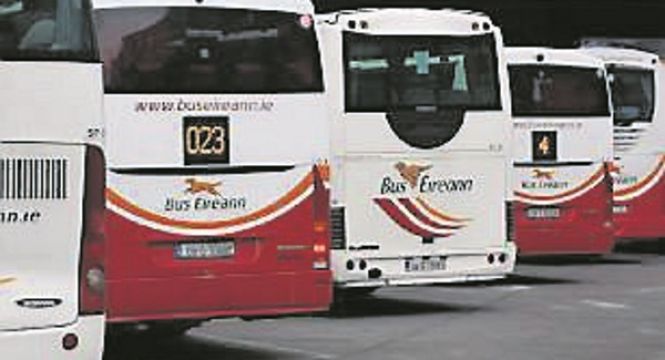Almost one in 10 of all passengers on Bus Éireann services were found to be travelling without a valid ticket, according to the results of fare evasions surveys carried out by the National Transport Authority.
The research also found that almost 10 per cent of passengers on bus routes operated by GoAhead Ireland in the greater Dublin region did not have a valid ticket for their journey.
However, a similar survey found the level of fare evasion on Dublin Bus services much lower at under four per cent.
The results, which highlight fare evasion rates on public transport bus companies over an 18-month period to June 2023, were released under freedom of information legislation.
The findings of a similar study published earlier this year revealed fare evasion rates on Iarnród Éireann services averaged six per cent.
However, Transport Infrastructure Ireland, which carried out similar research in respect of fare evasion rates on Luas services, has refused to make its findings publicly available.
TII claimed releasing the information “could reasonably be expected to exacerbate such fare evasion, which is a criminal offence.”
The survey of over 12,000 passengers on over 100 different Bus Éireann services found an average fare evasion rate of 9.1 per cent.
The results covered bus routes operating in the main cities outside Dublin, including Cork, Galway, Limerick and Waterford as well as provincial services to and from Dublin, but excluding Expressway services.
The lack of valid tickets resulted in a reduction in fare income of 7.4 per cent.
The highest evasion rates were found on provincial routes serving Galway to destinations such as Clifden and Athlone where the proportion of passengers without valid tickets averaged 16.5 per cent.
Average evasion rates of almost 15 per cent were also recorded on the busy 101 and 101X service between Dublin and Drogheda.
Fare evasion rates on Bus Éireann services in the main cities were Cork (12.4 per cent); Galway (11.1 per cent); Limerick (9.9 per cent) and Waterford (5.4 per cent)
Some individual routes had very high evasion rates with more than half of all passengers checked on two routes – 261 (Cork-Ballinacurra) and D2 (Drogheda-Laytown) – not having valid tickets.
Fare evasion rates over 25 per cent were also recorded on several other busy routes including the 216 (Cork University Hospital-Monkstown); 475 (Sligo-Coolaney); 236 (Cork-Castletownbere); 109 (Dublin-Kells-Cavan) and 226 (Kent Station-Kinsale).
However, passengers on over 30 different routes were found to be fully compliant with paying the correct fare.
The NTA survey revealed Dublin Bus, which carried 121.4 million passengers last year, had an average fare evasion rate of 3.6 per cent.
The survey of over 12,200 passengers across over 80 routes showed the lack of valid tickets resulted in a loss of revenue of 4.3 per cent on due fares.
Among those who had not paid the correct fare, 71% were found to have no ticket, while 26% were “overriding” with the remainder either having a wrongly classified or expired ticket.
On individual routes, the highest evasion rate was on the former 79 (now 60) route (Aston Quay-Cherry Orchard) with 64% of passengers not having a valid ticket.
Other services with high evasion rates were the 54A (Pearse Street-Kiltipper Way) at 30%; 77X (Citywest-UCD) at 13% and 77A (Ringsend-Citywest) at 10%.
In contrast, no evasion was discovered on 21 routes including the 130 (Talbot Street-Clontarf); 38B (Burlington Road-Damastown); 41D (City Centre-Swords Business Park); 65 (City Centre-Blessington) and N4 (Point Village-Blanchardstown Shopping Centre).
A separate survey of GoAhead Ireland, which operates suburban routes in Dublin and provincial routes in the greater Dublin region, found an average evasion rate of 9.8% on its services with a resultant loss in revenue of 7.2%.
Tickets of over 7,000 passengers across 43 services were checked with 17 routes having fare evasion rates in excess of 10%. No fare evasion was detected on nine routes.
The average evasion rate on its “Dublin commuter services” which operates routes to the capital from towns like Edenderry, Newbridge and Kildare was 12.4%.
In contrast, the average rate on its services in the “outer Dublin metropolitan area” was 6.7%.
On the provincial routes, the highest evasion rate was on the 130 (Athy-Kilcullen-Naas-Dublin) at 23%.
Among GoAhead Ireland’s suburban services the worst evasion rate was on the 270 (Dunboyne-Blanchardstown) route at 13%.
The evasion rate was 11% on several other routes including 63/63A (Kiltiernan-Dún Laoghaire); 102 (Dublin Airport-Sutton DART station) and 184 (Newtownmountkennedy-Greystones-Bray).
A spokesperson for the NTA said the surveys had been commissioned to ascertain the level of fare evasion with public transport companies operating services under contract from the NTA “to identify any trends.”
Since the start of 2023, the NTA receives all revenue collected from bus, train and light services operated under “public service contract” routes, which are deemed commercially unviable without a form of subsidy or where their provision is considered socially desirable.
The spokesperson said the performance of public transport providers in relation to fare evasion rates was now part of the system of incentives and deductions under direct award public service contracts.
Fare evasion “thresholds” are set for individual bus and rail service providers with performance measured on a quarterly basis.
The NTA stressed that the fare evasion surveys were different from enforcement measures carried out by the staff of public transport providers.
The surveys revealed fare evasion rates were highest among 19-25 year olds on both Bus Éireann and GoAhead Ireland services.
In contrast, the evasion rate was highest among 56-65 year olds among Dublin Bus passengers.
No marked difference was found in evasion rates between male and female commuters.







